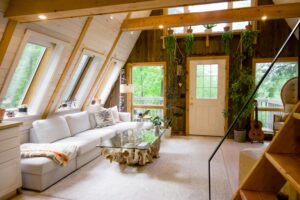11 Inspiring Eco-Friendly House Design Elements That Prioritize Sustainability
 An eco-friendly house project is a wise investment in sustainability as it reduces carbon footprints while creating healthier, more efficient living spaces. Sustainable home design integrates energy-efficient systems and cutting-edge technologies to minimize environmental impact without sacrificing comfort.
An eco-friendly house project is a wise investment in sustainability as it reduces carbon footprints while creating healthier, more efficient living spaces. Sustainable home design integrates energy-efficient systems and cutting-edge technologies to minimize environmental impact without sacrificing comfort.
For example, solar panels and smart energy management help homeowners lower utility bills and reduce waste. Meanwhile, innovative design elements — like passive cooling, green roofs and water-saving systems — make eco-friendly homes functional and future-proof. Prioritizing sustainability conserves natural resources and promotes a cleaner way of living.
1. Passive Solar Design
Passive solar design maximizes the sun’s natural energy to heat and cool a home efficiently without relying on mechanical systems. Through smart energy strategies, it reduces heating and cooling loads to cut energy consumption and utility costs. The design focuses on strategically placed windows that capture sunlight in winter while minimizing summer heat gain.
Thermal mass materials — like concrete or brick — absorb and store heat, releasing it gradually to maintain a stable indoor temperature. Shading devices, such as overhangs or pergolas, help control sunlight exposure to prevent overheating in warmer months.
2. Green Roofs and Living Walls
Green roofs offer a powerful combination of insulation, water management and environmental benefits, which makes them a standout eco-friendly house feature. Adding a layer of vegetation on rooftops provides natural insulation and reduces heat loss in winter. This extra layer also traps rainwater, reduces stormwater runoff and eases pressure on drainage systems.
Beyond energy efficiency, green roofs support biodiversity, creating habitats for pollinators and small wildlife. Similarly, living walls improve air quality by filtering pollutants. They also increase oxygen levels while regulating indoor temperatures by adding an extra barrier against heat and cold.
3. Solar Panels and Renewable Energy Systems
Installing solar panels or wind turbines for home energy production offers a reliable way to reduce electricity costs and minimize environmental impact. Generating clean, renewable energy on-site can lower homeowners’ reliance on fossil fuels, cut utility bills and sell excess power back to the grid in some areas.
Additionally, battery storage solutions and other high-capacity systems allow homeowners to store excess energy during cloudy days or nighttime. With these innovations, renewables are becoming more efficient, accessible and aesthetically integrated into sustainable house design.
4. Eco-Friendly Paints and Finishes
Choosing low-VOC and zero-VOC paints is a simple yet effective way to improve indoor air quality while reducing environmental impact. Traditional paints release volatile organic compounds VOCs), which cause respiratory issues and contribute to air pollution. Waterborne alkyd paints offer a lower-VOC alternative, emitting fewer fumes and gases while maintaining durability and a smooth finish.
For a more sustainable house feature, natural paints made from clay, chalk or plant-based ingredients provide a nontoxic, breathable coating that preserves indoor air quality. Homeowners can also opt for recycled or biodegradable paints, which repurpose leftover materials and break down naturally, reducing waste.
5. Water Conservation Systems
Water conservation is crucial to sustainable house design, and rainwater harvesting and greywater recycling offer innovative ways to reduce waste. Rainwater harvesting systems collect runoff from rooftops and store it for irrigation, toilet flushing or filtration for household use. Greywater recycling repurposes water from sinks and showers to cut down on freshwater demand.
Simple upgrades like low-flow faucets, showerheads and water-efficient appliances can help Americans use at least 20% less water, which lowers consumption and utility costs. Meanwhile, drought-resistant landscaping — featuring native plants and permeable surfaces — reduces irrigation needs.
6. Sustainable and Recycled Building Materials
Sustainable house features are often made of bamboo, reclaimed wood and rammed earth. Bamboo grows rapidly and offers a durable, renewable alternative to hardwood, while reclaimed timber repurposes old materials. This approach reduces deforestation and adds unique character to a home.
Rammed earth walls provide excellent insulation and thermal mass, naturally regulating indoor temperatures. Beyond material selection, sourcing locally helps cut carbon emissions by reducing the need for long-distance transportation.
7. Smart Home Technology for Energy Efficiency
Smart home technology helps homeowners cut waste, lower costs and reduce their carbon footprint. For example, smart thermostats learn household routines and adjust heating and cooling automatically. Energy-monitoring systems provide real-time insights into electricity usage to help homeowners identify inefficiencies and optimize consumption.
With the building and construction industries responsible for 37% of global greenhouse gas emissions, eco-friendly house projects can lower this impact. Developers can integrate automated lighting to ensure lights are only on when needed, reducing unnecessary energy use.
8. Energy-Efficient Insulation
Proper insulation reduces energy consumption and creates a more comfortable home. Well-insulated spaces prevent heat loss in winter and keep interiors cool in summer, lowering the need for excessive heating and cooling. Natural insulation materials — including vegetal fibers and products from recycled industrial and agricultural waste — offer excellent thermal performance while minimizing environmental impact.
Wool insulation naturally regulates moisture and provides fire resistance, while cellulose insulation, made from recycled paper, delivers strong thermal retention and soundproofing. These eco-friendly house features reduce carbon footprint and create a healthier living environment.
9. Net-Zero and Passive House Standards
Net-zero homes and Passive House certifications focus on low energy consumption and high performance. A net-zero home generates as much energy as it uses annually, relying on superior insulation and renewable sources like solar panels. A Passive House certification goes further with strict efficiency standards, reducing heating and cooling needs more than conventional homes.
Both approaches prioritize high-performance windows, advanced ventilation systems, and minimal energy waste. They create eco-friendly house projects that stay comfortable year-round and have lower utility costs. Integrating renewables and cutting-edge building techniques enhances indoor comfort and air quality.
10. Sustainable Landscaping and Outdoor Spaces
Sustainable landscaping protects ecosystems, preserves biodiversity and improves water and air quality. Techniques like xeriscaping — which uses drought-resistant plants and minimal irrigation — help conserve water while maintaining beautiful outdoor spaces. Native plant gardens support local wildlife and reduce the need for chemical fertilizers and pesticides.
Edible landscaping combines functionality with sustainability by incorporating fruit trees, herbs and vegetables into outdoor designs. This promotes local food production and reduces reliance on store-bought produce. Permeable paving also allows rainwater to filter into the ground, reducing runoff and replenishing groundwater supplies.
11. Modular and Prefabricated Eco-Friendly Homes
Prefabricated homes reduce waste and improve efficiency. Built in controlled factory settings, they use precise material measurements, minimizing excess waste. This is a crucial advantage as the U.S. generated 600 million tons of construction debris in 2018. Modular designs take sustainability further by incorporating eco-friendly materials like recycled steel and high-performance insulation.
Many prefab homes also feature energy-efficient systems — like solar panels and smart climate controls — reducing long-term consumption. With faster construction times, lower costs and a smaller carbon footprint, these homes offer a greener alternative to traditional homebuilding.
A Greener Future Starts at Home
Sustainability is achievable through minor upgrades and design choices, from installing energy-efficient lighting to building a net-zero home. Embracing eco-friendly materials, smart technology and water-saving solutions can create healthier living spaces while reducing ecological impact.


